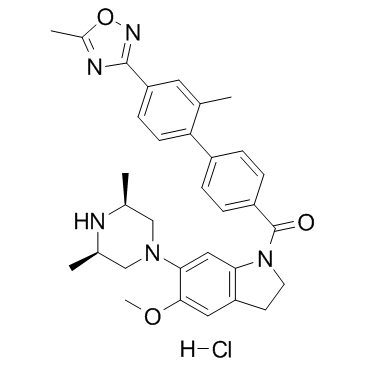SB-616234A |
| Catalog No.GC31025 |
SB-616234A is a selective and orally bioavailable 5-HT1B receptor antagonist, with anxiolytic and antidepressant activity.
Products are for research use only. Not for human use. We do not sell to patients.

Cas No.: 908601-49-0
Sample solution is provided at 25 µL, 10mM.
SB-616234A is a selective and orally bioavailable 5-HT1B receptor antagonist, with anxiolytic and antidepressant activity.
SB-616234A possesses high affinity for human 5-HT1B receptors stably expressed in Chinese hamster ovary (CHO) cells (pKi 8.3 ± 0.2), and is over 100-fold selective for a range of molecular targets except h5-HT1D receptors (pKi 6.6 ± 0.1). Similarly, affinity (pKi) for rat and guinea pig striatal 5-HT1B receptors is 9.2 ± 0.1. In [35S]-GTPγS binding studies in the human recombinant cell line, SB-616234A acts as a high affinity antagonist with a pA2 value of 8.6 ± 0.2 whilst providing no evidence of agonist activity in this system. In [35S]-GTPγS binding studies in rat striatal membranes, SB-616234A acts as a high affinity antagonist with an apparent pKB of 8.4 ± 0.5, again whilst providing no evidence of agonist activity in this system. SB-616234A (1 μM) potentiates electrically stimulated [3H]-5-HT release from guinea pig and rat cortical slices (S2/S1 ratios of 1.8 and 1.6, respectively)[2].
SB-616234A reverses the 5-HT1/7 receptor agonist, SKF-99101H-induced hypothermia in guinea pigs in a dose related manner with an ED50 of 2.4 mg/kg p.o. SB-616234A produces dose-related anxiolytic effects in both rat and guinea pig maternal separation-induced vocalisation models with an ED50 of 1.0 and 3.3 mg/kg i.p., respectively[1]. SB-616234A (0.3-30 mg/kg p.o.) causes a dose-dependent inhibition of ex vivo [3H]-GR125743 binding to rat striatal 5-HT1B receptors with an ED50 of 2.83 ± 0.39 mg/kg p.o[1].
[1]. Lee A.Dawson, et al. Characterisation of the selective 5-HT1B receptor antagonist SB-616234-A (1-[6-(cis-3,5-dimethylpiperazin-1-yl)-2,3-dihydro-5-methoxyindol-1-yl]-1-[2′-methyl-4′-(5-methyl-1,2,4-oxadiazol-3-yl)biphenyl-4-yl]methanone hydrochloride): In vivo neurochemical and behavioural evidence of anxiolytic/antidepressant activity. Neuropharmacology Volume 50, Issue 8, June 2006, Pages 975-983 [2]. Scott C, et al. SB-616234-A (1-[6-(cis-3,5-dimethylpiperazin-1-yl)-2,3-dihydro-5-methoxyindol-1-yl]-1-[2'methyl-4'-(5-methyl-1,2,3-oxadiazol-3-yl)biphenyl-4-yl]methanone hydrochloride): a novel, potent and selective 5-HT1B receptor antagonist. Neuropharmacology. 2006 Jun;50(8):984-90. Epub 2006 Mar 20.
Average Rating: 5 (Based on Reviews and 40 reference(s) in Google Scholar.)
GLPBIO products are for RESEARCH USE ONLY. Please make sure your review or question is research based.
Required fields are marked with *




















